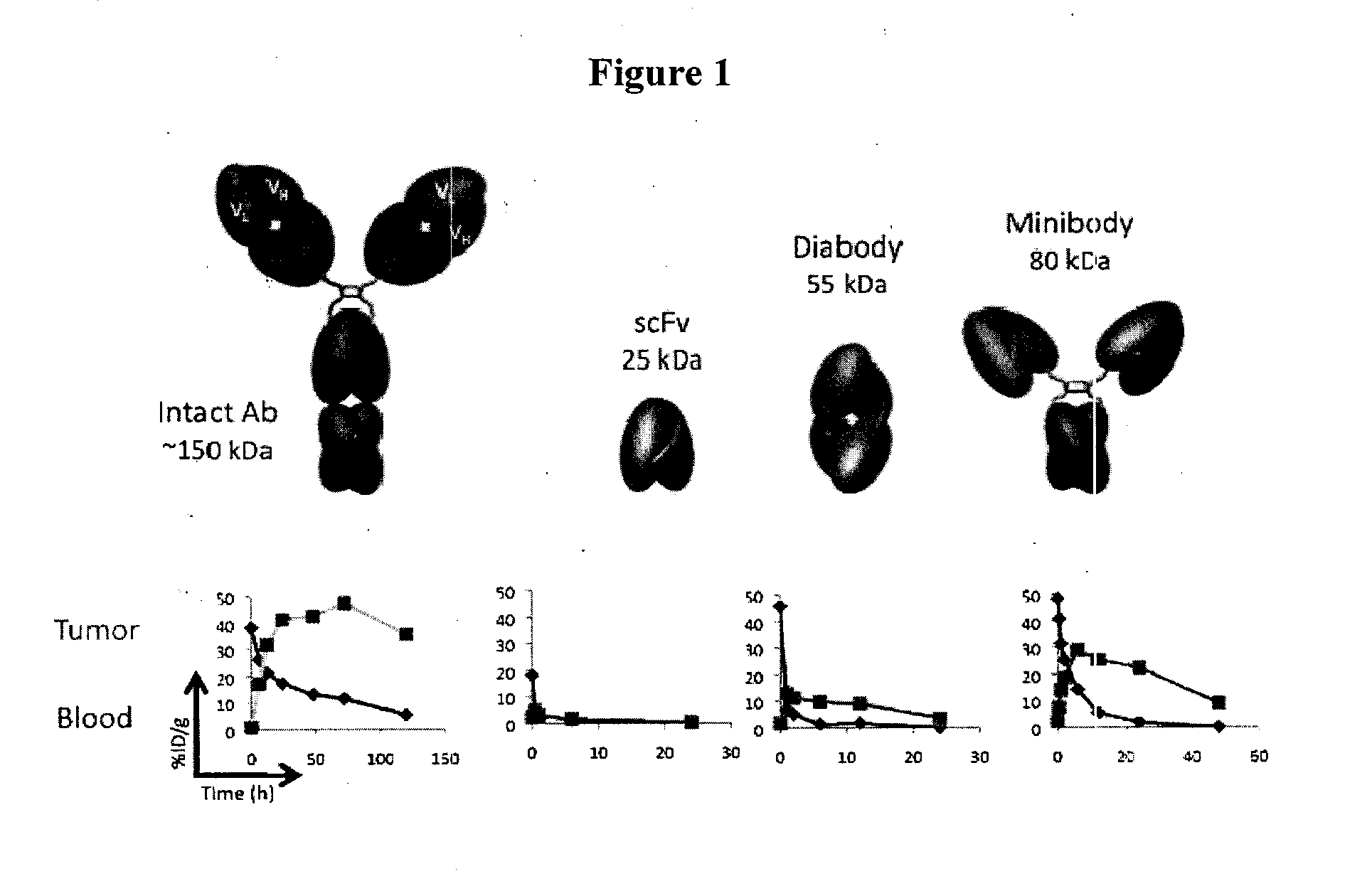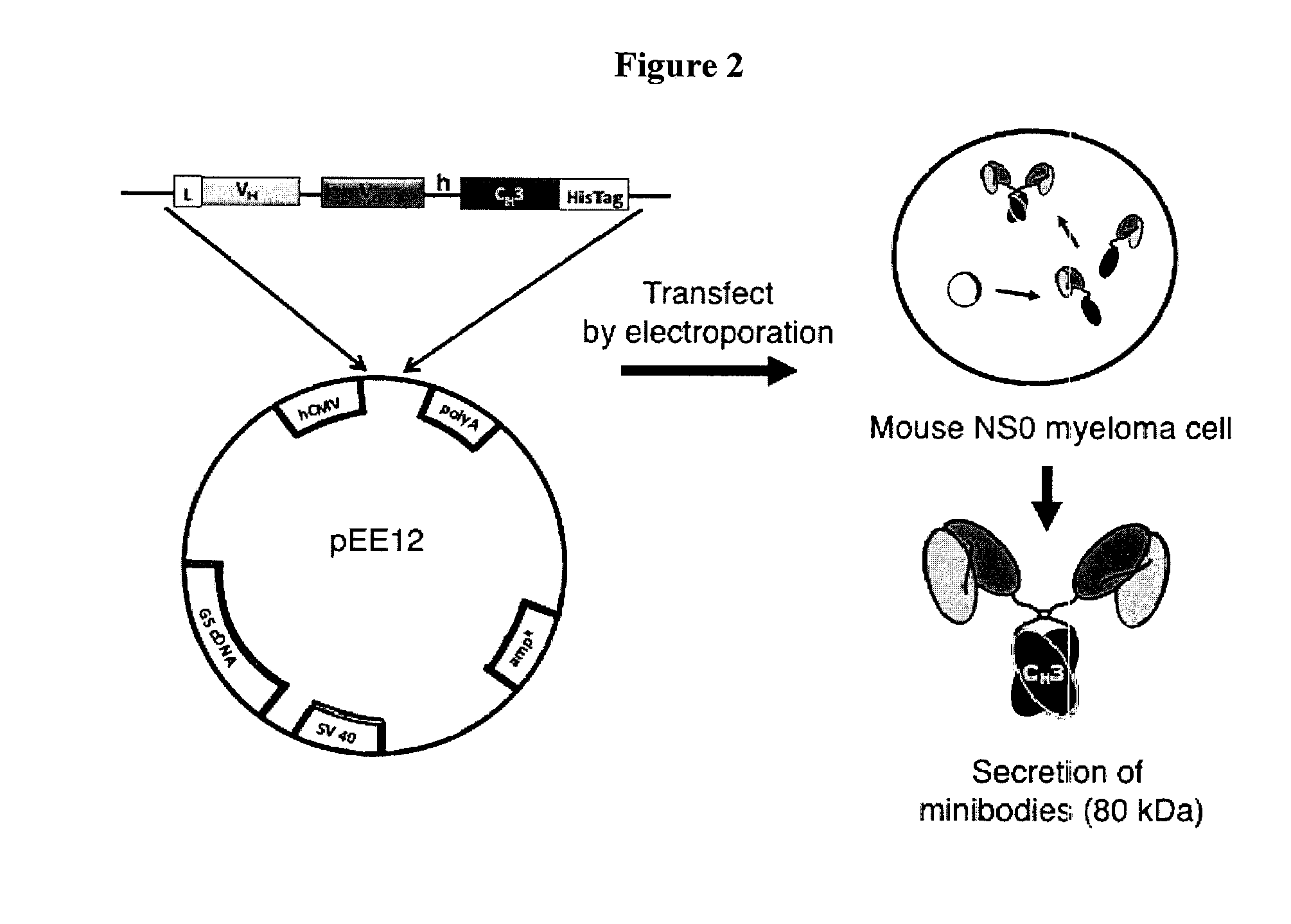Engineered antibody fragments for targeting and imaging cd8 expression in vivo
a technology of cd8 and antibody fragments, applied in the field of mouse cd8 imaging in vivo, can solve the problems of inability to provide dynamic information, prone to error in invasive tissue sampling methods, and difficulty in non-invasive monitoring of immune cells in the fields of infection, cancer and autoimmunity, and achieve the effect of improving the accuracy of immunotherapy protocol evaluation, and improving the quality of immunotherapy
- Summary
- Abstract
- Description
- Claims
- Application Information
AI Technical Summary
Benefits of technology
Problems solved by technology
Method used
Image
Examples
example 1
Design and Production of the Anti-CD8 Minibodies
[0323]Determination of VH and VL Sequences from Parental Hybridomas.
[0324]The YTS169 hybridoma was obtained from the Therapeutic Immunology Group at Oxford University, UK and cultured in Iscove's Modified Dulbecco's Medium (IMDM) plus 10% FBS and Pen / Strep (21). The 2.43 hybridoma was obtained from ATCC (TIB-210) and cultured in DMEM plus 10% FBS and Pen / Strep. VH and VL sequences were obtained by RT-PCR using primers published by Dubel, S., et al. (Dubel S. et al., Isolation of IgG antibody Fv-DNA from various mouse and rat hybridoma cell lines using the polymerase chain reaction with a simple set of primers. J Immunol Methods. Sep. 30 1994; 175(1):89-95). For the hybridoma 2.43, the obtained VH and VL sequences were confirmed with trypsin digest-mass spectrometry of the purified parental antibody performed at the UCLA core facility. The YTS169 hybridoma was engineered to antibody fragments without further VH and VL validation.
[0325]S...
example 2
In Vivo Preparation and Administration of Anti-CD8 Minibodies
[0348]CD8 depletion. Mice were treated for three consecutive days with 330 μg of anti-CD8 depleting antibody (Clone 53-6.7 purchased from UCSF Monoclonal Antibody Core) injected intraperitoneally (165 μL in saline) or 250 μg of 2.43 minibody injected intravenously (125 μL in saline). Two to three days post-treatment, single cell suspensions from the spleen, peripheral blood, thymus and lymph nodes were isolated and stained as described above for CD8 depletion analysis.
[0349]SCN-NOTA Conjugation.
[0350]All solutions were made metal-free (MF) using Chelex 100 (1.2 g / L; BioRad). The 2.43 and YTS169 Mbs were dialyzed against MF-PBS overnight using Slide-A-Lyzer MINI dialysis units (Thermo Scientific). Proteins at 1-2 mg / mL were then incubated with an 80-fold molar excess of S-2-(4-Isothiocyanatobenzyl)-1,4,7-triazacyclononane-1,4,7-triacetic acid (p-SCN-Bn-NOTA; Macrocyclics) for 4 hours at 4° C. pH was adjusted to 8.5 using 1 ...
example 3
Production of Anti-CD8 Antibodies
[0360]Sequencing Variable Regions of Parental Rat Anti-Murine CD8 Antibodies.
[0361]RT-PCR was repeated until at least 2 individual experiments produced three replicates of the same sequence for the VH and VL domains for each hybridoma. For sequence validation of hybridoma 2.43, the VH and VL from RT-PCR sequences were confirmed with tryptic digest-mass spectrometry of the parental antibody. VH amino acid coverage was 35% (41 / 117) including the complete CDR1 and half of CDR2 and VL amino acid coverage was 62% (66 / 107) including both CDR2 and CDR3. For YTS169, no sequence verification was performed.
[0362]For the hybridomas YTS 105 and YTS 156, the sequences were compared to the crystal structures of the Fab fragment in complex with either sCD8a or sCD8β deposited with PDB ID codes 2ARJ and 3B9K, respectively. RT-PCR sequences for YTS 105 were identical to the published crystal structure except for a few mutations at the 5′ and 3′ terminal ends due to t...
PUM
| Property | Measurement | Unit |
|---|---|---|
| Time | aaaaa | aaaaa |
| Length | aaaaa | aaaaa |
| Volume | aaaaa | aaaaa |
Abstract
Description
Claims
Application Information
 Login to View More
Login to View More - R&D
- Intellectual Property
- Life Sciences
- Materials
- Tech Scout
- Unparalleled Data Quality
- Higher Quality Content
- 60% Fewer Hallucinations
Browse by: Latest US Patents, China's latest patents, Technical Efficacy Thesaurus, Application Domain, Technology Topic, Popular Technical Reports.
© 2025 PatSnap. All rights reserved.Legal|Privacy policy|Modern Slavery Act Transparency Statement|Sitemap|About US| Contact US: help@patsnap.com



